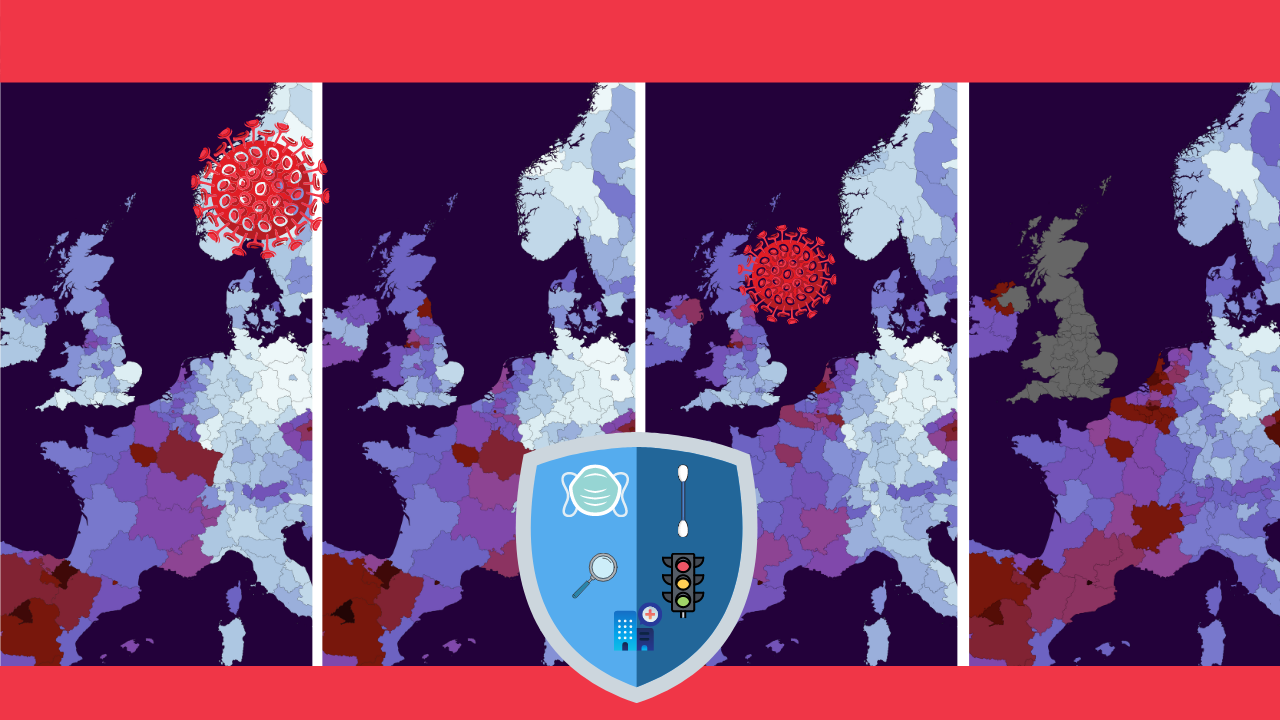
With the onset of autumn, the second corona wave has also erupted. Spain, Romania, and France already had to deal with this back in August. During the past week, the COVID bear is on the loose in the Czech Republic, which is now the continental COVID hotspot. But in fact, autumn woes have flared up everywhere.
Governments and societies are under great pressure. The decisions they make over the next few weeks will probably determine the entire course of the coming winter. Nobody wants a lockdown. But exactly how do you avoid this scenario? That is at the heart of this edition.
To start with, it is useful to know what the situation is like right now. The sliders below show the latest Corona map of Europe compared to last week and four weeks ago.
‘Virus does not respect borders’
The Czech Republic, France, Belgium, and the Netherlands broke several consecutive 24-hour records in the first full week of October. Especially the Czech Republic, which played a leading role in last week’s edition, stands out head and shoulders from the rest.
The Low Countries are close on its heels and the situation seems to be becoming unmanageable here as well. In the Netherlands, the Randstad region is the biggest hot spot. While in Belgium, the French-speaking regions appear to be taking the hardest hits. What is striking about this is that the Nord-pas de Calais region in Northern France also seems to be sliding along with Wallonia.
Furthermore, the United Kingdom also recorded unprecedentedly high increases, but this was caused by a technical malfunction at the NHS. Due to limitations within the Excel program, over 16,000 patients were not registered correctly. They caught up with this last week, which invariably led to unrealistically high spikes.
Spain seems to be cooling down a little after a disastrous August and September. Nevertheless, Madrid and Navarre are still among the regions with the most new diagnoses per capita. This is not the case in Central Europe where there has been a noticeable increase for several weeks in a row. The situation is also starting to deteriorate in Finland, Germany, and Italy, where things have been relatively quiet so far. At the beginning of October, Cyprus and Serbia are the most corona-free countries in Europe.
Nevertheless, infections do not tell the whole story. A country that tests a lot, will, as a rule, also register more infections.
The pandemic frontlines
From a purely Darwinian point of view, SARS-CoV-2 is a fairly successful virus that can spread unseen throughout societies. The virus has a fairly long incubation period. In addition, it is extremely contagious. It leads to mild symptoms in a large proportion of patients, although this group is quite capable of transmitting the virus. Given that very few tests were carried out in the spring, the downturn in health was only noticeable when vulnerable target groups became seriously ill.
The first and foremost defense fortress is society itself. If each individual resident carefully respects social distancing rules and sticks to hand-washing, avoiding crowds, and limiting social interaction, the virus won’t stand a chance. Yet after three quarters of a year of pandemic misery, public support is beginning to dwindle. People are getting increasingly tired of it all. After a quiet summer, the need for basic rules for everyone seems to have disappeared into the background. Even the effectiveness of face masks is still a topic of discussion in some countries.
This is not without any risk. After all, an entire society that complies with all the basic rules to an absolute T is a utopia. And because the lion’s share of the disease is not serious and is difficult to distinguish from a cold, testing is a fundamental necessity. If you do not do this, the spread goes ‘underground.’ In order to prevent this, the European Centre for Disease Prevention and Control uses a detection threshold of 3%. If the proportion of positive tests in a country is above this value, this can eventually lead to overcrowded ICUs, death waves, and all sorts of misery. Can this be considered as a second line of defense? Absolutely.
Denmark, for example, reported quite a number of infections in mid-September. Yet the proportion of positive tests is still only 1%. This is because they are the most fanatical nasal swab collectors on the continent. By mapping the people infected (and putting them in self-isolation) the pandemic does not get the chance to spread any further. The beneficial effects are already noticeable. After a pandemic spike in September, the number of new infections has actually dropped in Denmark. Which is practically unheard of in the rest of Europe.
The number of countries that are testing at sufficient levels in early October is gradually starting to drop. Only Germany, the Baltic States, and Scandinavia are currently in compliance with the European directives. The Netherlands and the Czech Republic recorded a high percentage of positive tests. Plus, in the past weeks also showed the largest spike in infections, which, moreover, have been growing at an ever-increasing rate. This is not surprising considering that after seven months, corona testing is still not up to standard here.
The graphic below shows the number of tests per day over the past six months. In most countries, testing capacity has increased enormously. As a result, this autumn’s infection figures cannot in all fairness be compared side-by-side with those at the beginning of this year.
Not only capacity but also the conditions for testing vary. Who will be tested: Only people with symptoms? Or anyone who wants to be tested? European countries are thinking along these lines.
First aid for corona clusters
Nevertheless, with just a lot of testing, you will not be able to completely solve all of the problems. The coronavirus primarily spreads in so-called clusters. A patient can (sometimes unintentionally) infect dozens of others. More than half a year of research has shown that this is most likely to happen in spaces with poor ventilation where many people clump together in combination with yelling, singing, or under the influence of alcohol. Infections can also occur in the open air during a conversation, but the chance of cluster formation is much smaller. You can read more about this in a very interesting feature in The Atlantic.
Adequate contact tracing is the second important weapon against corona clusters. This is carried out by researchers or via an app. The most important goal? To look for the source of the viral infection. This is invariably a particular time or place in the past and cannot always be pinpointed. But if this is successful, you can approach, test, and also do contact tracing on everyone who was present at that time. If the third line of defense of contact tracing goes smoothly, the number of infections around this cluster should eventually be reduced to zero. Self-isolation which has a mandatory character plays a fundamental role in this. If a patient does go for a walk despite their illness, you can still do as many tests and examinations as you like, but you are fighting a running battle.
Why have East Asian countries such as Taiwan, Japan, and South Korea never experienced major problems with the corona pandemic? Contact tracing had been optimally organized there since the outset of the crisis. As a result, every initial hot spot was trampled with technology and expert detection work. In Germany, too, they seem to understand this perfectly. Despite the fact that they are in the mid-range in terms of testing capacity, they have always managed to keep the situation under control.
In Spain, contact tracing never got off the ground. It is therefore no coincidence that it was especially there that the pandemic woes were greatest in the spring and during the summer months. The Netherlands does formally carry out contact tracing but is struggling with substantial backlogs due to the autumn peak. Even fewer researchers were hired in the summer than had been agreed upon. The Municipal Health Services (GGD) did not think this was necessary because there was not enough work for them at that time. Meanwhile, in several regions, viral detection work has been scaled down considerably.
The prevention of cluster infections is therefore the reason why limits have been introduced on the number of attendees at gatherings. There is a lot of discussion about the role that schools play in this regard. This can also be seen in the school policy in Europe.
Escalation ladders and traffic lights
Because Europe was taken by surprise in the spring, almost all countries implemented a costly – and at times unnecessary – rural lockdown. The advantage of this drastic remedy is that it guarantees to lower infections and give the hospitals some breathing space. However, the social and economic disadvantages associated with it are also the most grave. This is therefore considered as a very last resort if the previous defensive measures did not get the virus under control.
Nevertheless, the situation can vary greatly from region to region. If the testing, tracing, and isolation in a certain area do not lead to the hot spots being extinguished, then it is possible to opt for stricter measures in a certain area. This is also referred to as a ‘traffic light system’ or an ‘escalation ladder.’ If certain threshold values are exceeded, this leads step-by-step to concrete measures. These are determined preferably in advance. How well this fourth shield will work, remains to be seen.
In Germany, the federal states take charge of this task on an individual basis. The United Kingdom is expected to roll out a traffic light system over the next few weeks. The Netherlands also experimented with this, but the warning levels still lack concrete consequences for specific risk levels – or any kind of rules whatsoever.
Ireland has been running a very extensive escalation ladder from Europe for some time now, which does look very clear. At least on paper.
IC capacity and hospitals
If all attempts to contain the spread are unsuccessful, there is one last line of defense that can prevent a pandemic death wave: hospital care. Given that a lot of COVID-19 patients can become seriously ill within a very short period of time, hospitals run the risk of becoming overwhelmed. By definition, overburdened hospitals are a humanitarian disaster. Not only because of the corona patients who cannot all be helped, but also severely ill patients who require intensive care for other conditions. This led to a huge disaster in the north of Italy in the spring. Triage was also practiced in overcrowded hospitals in the United States, Spain, and Israel. As a result, people died, who would have otherwise been saved outside the corona timeline.
IC capacity varies greatly from country to country. Although there was criticism in Germany itself about their expensive stand-by capacity, they will certainly be pleased with it now. The Germans currently have so many beds available that they are even accommodating patients from neighboring countries. With 29.2 ICU beds per 100,000 inhabitants, they could even cope with a massive patient wave. If corona really gets out of hand this autumn, then the German healthcare system will be able to keep its head above water for the longest amount of time. Whereas Madrid is trying to expand the capacity of a dedicated corona emergency hospital in recent weeks so as to avoid having to mourn tens of thousands of deaths once more.
However, this healthcare capacity is not necessarily needed. If the first lines of defense are able to prevent the flow of patients in advance, far fewer will need to be treated in a hospital. In most cases, national measures are also tightened up at the same time.

The truth will come out in the weeks to come
In Europe, preparations are finished and defense tactics are being put to the test by the swirling aerosols of the second wave. The world learned in spring that total lockdowns can beat the virus. But few are eager to pull this ‘blunt’ emergency brake again. In theory, this tough slamming of the emergency brakes ought not to be necessary at all. As long as the basic rules, test capacity, contact tracing, and regional measures are properly adhered to. As such, it should be the case that months of preparation have been put to good use. A luxury that did not exist in spring.
The fact that a lot of Europeans will be infected with COVID-19 in the coming months is unavoidable. What can be prevented is how significant the social impact and pandemic scale will be. For the second time, governments, economies, and societies are being subjected to an unsolicited macabre stress test. Whoever has their pathogen positions sorted out in the best possible way, will automatically be revealed in the near future. Which country will weather this microbiological autumn storm the best?
The damage is already being felt in some countries in terms of pressure on hospitals and rising mortality rates. Although this is by no means comparable to the first wave, in the past four weeks, almost 5,000 lives have been lost from a COVID-19 infection in Spain, the Czech Republic, and Romania alone.







